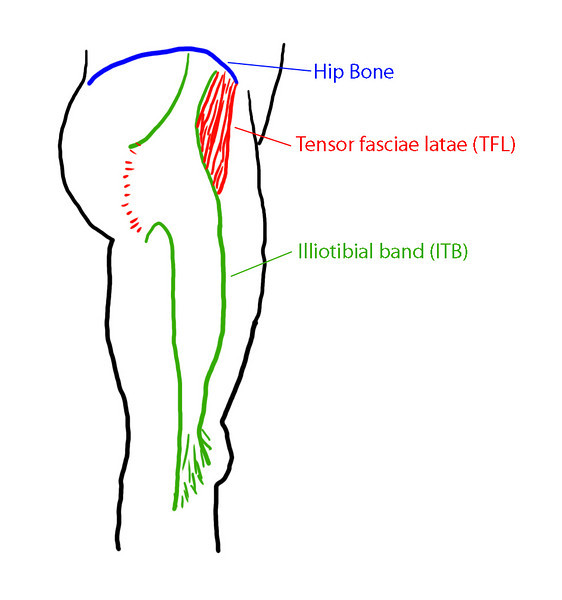Iliotibial band syndrome
Iliotibial band syndrome (ITBS) generally causes pain in the outside of the knee. The Iliotibial band (ITB) runs from the crest of the hip bone (Iliac) to the top of the shin bone (tibia) near the knee, hence the name. You can see the ITB in green in the picture below.
There are a number of approaches to treating ITBS.
Contents
1 Avoid Fuel Belts
Though the pain of ITBS is felt near the knee, the origin of the ITBS is at the hip. Therefore anything that presses on the ITB high on the leg, or worse the TFL can cause or aggravate ITBS. If you have been wearing a fuel belt, or any other type of belt around the hips, I'd recommend not wearing it until the ITBS has completely recovered. If you feel the fuel belt is worth it, try reintroducing it and see if the ITBS reoccurs.
2 Massaging The Tensor Fasciae Latae
I have found the most effective treatment for ITBS is to focus on the Tensor Fasciae Latae (TFL), shown above in red. I use the Thumper to massage the TFL, which can be quite painful, but I have found that my ITBS symptoms subside very rapidly after treatment. For a wonderful visualization of the TFL, check out http://www.getbodysmart.com/ap/muscularsystem/thighmuscles/anteriormuscles/tensorfasciaelatae/tutorial.html
3 Foam Roller
Using the Foam Roller to massage the ITB from the hip to the knee can help treat ITBS. This can be quite painful, so using your other leg to reduce the pressure is often needed to keep things bearable.
4 Strengthen the TFL
One of the best exercises for strengthening the TFL is the 'Frankenstein march'. To do this you will need a stretch band with handles similar to this one. To do the exercise, stand on the band with your feet shoulder width apart, holding the handles so the band goes from your right hand to your left foot and vice versa. You need enough tension on the strap so that when you walk, you have to put a little effort into keeping your feet apart. Walk a short distance, keeping your feet pointing straight ahead. Go far enough that you can feel the effort in your hips, but don't overdo it.
5 Ice
Using Ice on the site of the pain can help reduce the swelling and pain, but it does not seem to help address the root cause. Using ice is appropriate as part of a broader approach to treating ITBS.
6 Ibuprofen
NSAIDs like Ibuprofen will help mask the pain and can reduce the inflammation of ITBS, but they can also retard the healing process[1]. I would not recommend using Ibuprofen for ITBS.
7 Worn Shoes
It is possible for badly worn shoes to change your biomechanics enough to trigger ITBS. It's worth checking your shoes for excessive wear; not the tread on the outsole, but the midsole foam. Feel the thickness of the sole and see if it is significantly thinner in some sections, such as where the ball of the foot presses.
8 Biomechanics
Poor biomechanics can cause ITBS, so having someone evaluate your running form may help. Another approach is to have someone video tape your running and check it for good form.
9 References
- ↑ http://www.caringmedical.com/sports_injury/nsaids.asp SPORTS INJURIES, NSAIDs: Why We Do Not Recommend Them
